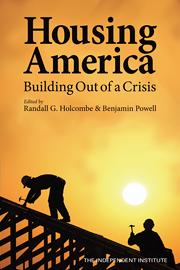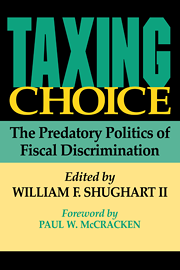Between 1929 and 1933, the Federal Reserve System, which is the central bank of the United States, monetarily starved the country into the worst economic crisis it has ever experienced. Markets, and the market system generally, did not fail, and nothing was inevitable about the collapse that occurred. Rather, the monetary system was so mismanaged that even a healthy and vigorous market system could not correct the disequilibrium that resulted.
The popular application of “market failure” to describe the economy during the years of the Great Contraction, 1929–1933, is wrong. Market actions in that era made the politically inspired crisis less severe than it otherwise would have been. Furthermore, “market failure” is a term people often apply to events when they cannot understand the complexities of economic processes that result from ill-conceived government policies. The operations of just about any monetary system, and especially one with a central bank, are always puzzling to the layman. Consequently, when things go wrong owing to monetary mismanagement by central bankers or some other political intervention, the instigators can ring in “market failure” as an excuse for their personal failures to make the right decisions.
Failure in other aspects of human endeavor often generates learning that subsequently leads to correction and eventual success.1 Federal Reserve policy failure in 1929–1933, however, led only to federal legislation that increased the number and power of federal government agencies. The Republican Hoover administration, for example, initiated the expensive Reconstruction Finance Corporation in 1932 to carry out lending policies that the elaborately structured Federal Reserve System had failed to undertake. The Roosevelt administration then took control of the political machinery in 1933 and began a program of federal intervention and bureaucratic propagation that is mind-boggling even today.
Two items of Roosevelt-era legislation markedly affected the U.S. banking and monetary system. The first was the so-called Gold Reserve Act of 1934. This legislation gave the president the unconstitutional power to call in all privately owned gold for deposit in the U.S. Treasury. It also gave him the unconstitutional power by his fiat to revalue the price of gold (devalue the dollar) by as much as 60 percent.
Congress’s constitutional power to “regulate the value of money” was a power that could not be delegated to the executive. Furthermore, “regulate” did not mean a massive change in the monetary values of either gold or silver. Its sole purpose was to provide a means for congressional housekeeping control over the coinage system. Properly used, it allowed Congress to make incremental changes in the legal tender value of either gold or silver so that both metals would stay in circulation. It was put into the Constitution to counteract Gresham’s Law. Otherwise, changes in the market value of one or the other metal would result in what had now become the cheaper metal going to the mint and the other, dearer, metal going into the markets as a commodity.2
A New Central Banking Measure
The other piece of legislation, the Banking Act of 1935, was more momentous than the original Federal Reserve Act passed in 1913. In fact, the Act of 1935 might better have been labeled “The Central Banking Act of 1935,” because it virtually rewrote the earlier Act.
A central bank, like a gold standard, can assume many institutional forms that differ markedly from one another. The 1913 Fed Banks, for example, were regionally autonomous; the Board in Washington was relatively powerless. Board members were treated and paid on a scale similar to government employees in the U.S. Treasury, while the presidents of the regional Fed Banks commanded salaries comparable to those of executives heading major corporations. The Fed Banks’ gold reserves severely restricted their lending policies, as was proper under an operational gold standard. Finally, the real bills doctrine was supposed to furnish the grounds for Fed Banks’ accommodation of credit to their client member banks.
The Banking Act of 1935 changed the whole paraphernalia of monetary control. It vested the Federal Open Market Committee (FOMC) with complete discretionary control to determine the stock of money in the United States. Regional Fed Bank presidents still had five of the 12 seats on the FOMC, but the Board was now a seven-man majority. From that time on, the FOMC has fashioned monetary policy by authorizing the purchase (or sale) of U.S. government securities in the open market, an operation that the Fed Bank of New York conducts week by week.
When the FOMC buys the U.S. securities that the Treasury has previously sold to pay the government’s bills, it does so by creating money. This new money is either commercial bank reserves or Federal Reserve note currency. Clearly, if a 12-person board is determining the quantity of money that exists, the quantity of gold in the system has little or nothing to do with the money. Either a gold standard specifies the quantity of money in the economy, or a central bank does. A marriage of the two never lasts longer than an unhappy weekend.
The Gold Reserve Act of 1934 was the final divorce decree between gold and the monetary system. After January 31, 1934, no private household, bank, or business was allowed to own or hold more than a trivial amount of gold. Gold coin was forbidden for monetary purposes. This Act also authorized the president, Franklin Roosevelt, to raise the price of gold by 60 percent. Roosevelt, however, did not use all the power given him—only 98 percent of it. In early 1934, he increased the official mint price of gold, which had been $20.67 per ounce for 100 years, to $35 per ounce. The Treasury gold stock, valued at $4,033 million in January 1934, became $7,348 million in February 1934, an increase of $3,405 million by the decree of one man.3 The federal government had also, unconstitutionally, repudiated all gold clauses in its contracts and debts, so it did not have to share any of its newfound wealth with the private sector. In one month Congress and Roosevelt, by their legislative and administrative fiats, created seigniorage revenue from gold equal to one year’s ordinary tax revenues. In contrast, the federal government of 1834–1837, when it realized one year’s extraordinary revenue from land sales, returned that surplus to the state governments to be used or distributed as those sovereign governments saw fit.4
President Roosevelt rationalized this usurpation of private property rights in gold in one of his notorious fireside chats. “Since there was not enough gold to pay all holders of gold obligations,” he claimed, “the Government should in the interest of justice allow none to be paid in gold.”5
This rationalization of government confiscation was fatuous pretension. Gold in banks was then and had always been a fractional reserve against outstanding obligations. When the banks were on their own, they had adequate means to protect their reserves—gold, silver, or other legal tender. The Fed Banks and the U.S. Treasury-government institutions—also held only fractional reserves against their outstanding currencies. Use of gold as a recognized fractional reserve always precluded immediate liquidation of all monetary obligations into gold. So in effect Roosevelt was saying, “Since there was not enough gold to pay all holders of gold obligations, . . . the federal government should expropriate and keep all of the gold.”
The increase in the dollar price of gold, though other countries had gone off the gold standard or had also raised the price of gold in their own currencies, started a massive inflow of gold to the United States. Political apprehension in Europe and elsewhere also contributed to the U.S. accumulation. By 1940 the U.S. gold stock totaled $20 billion, or almost 20,000 tons! The contrast was notable between a government awash in gold and a depressed economy denuded of money and functioning with a shell-shocked banking system.
Fed Banks and the Treasury still accounted new gold coming into the U.S. system as though the gold were a monetary asset. The Treasury issued “Gold Certificates”—currency notes in $100,000 denominations-accounted at the new gold price of $35 per ounce, which it “deposited” in Federal Reserve Banks. Fed Banks then debited their “Treasury deposit” liability account, and credited their “Gold Certificates.” Whoever had received a check for the gold from the Treasury, however, had by now deposited that check in a commercial bank that in turn sent it to the Fed Bank for clearance. The Fed Bank cleared the check against the “Treasury deposit” account and debited the deposit-reserve account of the client bank by the same amount. No one could get the gold out of the Treasury, or touch it, or see it, or use it. (It was now a criminal act to use gold for monetary purposes!) Nonetheless, the gold provided an accounting medium for increasing the basic money stock of bank reserves and Federal Reserve note currency.
The Treasury in Control-The Fed Plays Ball
With all of the new gold coming into the system, the FOMC did not need to use its newly legislated powers. From 1933 to 1936, the M2 money stock grew at annual rates of 9.5, 14.0, and 13.0 percent.6 In fact, so much gold was coming into the Fed-Treasury’s coffers that sentiment in both the Fed and Treasury leaned toward monetary restriction.
The Fed had active hands-on control of monetary policy. Not only did it have the power to initiate open-market operations in government securities through the FOMC, but the Banking Act of 1935 also gave the Fed Board extensive control over member bank reserve requirements. Prior to the Banking Act, reserve requirements were statutory at 7, 10, and 13 percent-not based on the size of the bank, but on the size of the city in which the bank was located. The larger the city the higher the legal reserve requirement.7 The Banking Act of 1935 used the existing set of reserve requirements as the lower end of a new range of requirements: 7–14, 10–20, and 13–26 percent. Board of Governors’ decisions in Washington were to specify the precise set of requirements in force at any time. Thus Fed policy could be restrictive by mandating an increase in requirements.8
Banking Act or not, the Treasury was still very much in the monetary picture. Treasury Secretary Henry Morgenthau, Jr., had recommended to President Roosevelt the appointment of Marriner Eccles to be chairman of the Federal Reserve Board. Eccles outspokenly favored lots of federal spending and fiscal budget deficits. By his stance, he effectively signed over monetary policy to the Treasury. (Morgenthau had recommended Eccles for this reason.) The upshot of the arrangement was that Morgenthau ran the show. Both men favored a dominant fiscal policy that had Federal Reserve support. Although the new Banking Act took the secretary of the Treasury off the Fed’s Board of Governors (he had been the ex officio chairman), he now had a surrogate as chairman. He was more than satisfied to see his purposes served from behind the throne.
Even a surrogate position was not enough for Morgenthau. The realized seigniorage from the gold devaluation had given the Treasury a $2 billion windfall, accounted in an Exchange Stabilization Fund, that the Treasury was supposed to use to “stabilize” the dollar price of foreign currencies. The Treasury thus had a gold “position” and license for conducting gold policy.
Federal Reserve policy directed the first increase (50 percent) in reserve requirements in August 1936—from 7, 10, and 13 percent to 10 1/2, 15, and 19 1/2 percent. A few months later the Treasury initiated its own gold sterilization policy-the same policy the Fed had fostered in the 1920s. Its purpose was “to halt the inflationary potentialities [sic]” of all incoming gold. Beginning December 22, 1936, the Treasury placed its gold purchases in an “inactive” account. Instead of issuing gold certificates and depositing them in Fed Banks to raise the necessary credit balance to pay for the gold, the Treasury paid for the gold by selling government securities in financial markets. By this means, it carried out its own open market operations-sales in this case—with its own “FOMC.” This way the gold remained stockpiled but unmonetized in the Treasury.
Besides neutralizing the gold inflows, the policy was further deflationary because it brought more government securities into markets to compete with consumers’ and investors’ dollars. It thereby tended to raise interest rates as it inhibited general spending. In March and May of 1937, the Fed complemented this generally deflationary policy by increasing reserve requirements to the maximum allowable percentages: 14, 20, and 26 percent.
Fed-Treasury policy makers had acted deliberately and purposively. They believed in human management of the monetary system. Just before he was appointed Fed chairman, Eccles had boldly stated that the Fed should “support expansionary fiscal policy through discretionary monetary policy.”9 Unfortunately, the discretionary monetary policy now being practiced wasanything but expansionary. It was, in fact, extremely repressive.
Unprecedented Depression
However, the rest of the economy, unlike politically prosperous Washington, was moving at an unprecedentedly slow rate. Never before had a recession-depression been so tenured or so intense. By late 1936 business was picking up, but the price level was still 18 percent below its 1929 value, and unemployment was still 16 percent of the labor force. Nonetheless, the great concern in the Treasury and Federal Reserve was the danger of inflation! Fed and Treasury officials looked at the overhang of excess legal reserves in the banking system and imagined what would happen if the commercial banks expanded all those reserves into an avalanche of checkbook money. Monetary mismanagement had just provoked the most disastrous hyper-deflation in history. Yet, before all the foreclosures had been properly settled, the government’s monetary managers were contriving to counteract the inflationary potential that they had systematically built into the monetary machinery.
Secretary Morgenthau announced in a press release, dated December 20, 1936, that Treasury gold policy was coordinated with the Fed’s reserve requirement increases.10 By mid-1937 “inactive” gold in the Treasury was $1,087 million, or about 9 percent of total Treasury gold.
Meanwhile, the banking system and the private economy foundered in a new recession. If one were to write a script that chronicled the end of free-enterprise capitalism, the events of 1929–1938 would logically serve the purpose. Since few people understood the nuances of Fed-Treasury monetary policies, the common perception was that the Recession of 1937–1938 posed yet another failure of the market system. Dozens of tracts, novels, plays, and newspaper editorials reflected this notion.
The appearance of the depression-recession evidently convinced Morgenthau that the “danger of inflation” was passed. In September 1937 he released $300 million of gold from the inactive account thereby restarting the machinery of gold monetization. Gold certificate accounts at Fed Banks responded and gave rise as usual to increases in monetary base items in Fed Banks’ balance sheets. Finally, on April 19, 1938, Morgenthau announced the discontinuance of the inactive gold account altogether.
The time span of the Treasury’s gold policy was 16 months—December 1936 to April 1938, while the Fed’s reserve requirement increases occurred in August 1936 and March–May 1937, and continued in force with little change until after World War II. Treasury policy cut off new gold at the initial point of monetization; Fed policy effectively smothered the money-creating potential that old gold had already provided. For the next three years the economy stagnated. By 1941 the price level was still 14 percent below its 1929 value, and unemployment was still 10 percent of the labor force. Treatises appeared analyzing “the stagnant industrial economy.” The Keynesian notion of less-than-full-employment equilibrium seemed documented beyond reasonable doubt.
Fed-Treasury methods in the mid-1930s reflected the prevailing notion of the times-that someone had to run the show, that operations without the rule of men were destined to be “chaotic.” Economists and financial gurus were just as convinced of this argument as politicians and political scientists. One economist, Gove Griffith Johnson, commented in his contemporary book on Treasury policy: “One may be skeptical of the wisdom with which monetary instruments will be used, but the possibility of abuse extends throughout the whole sphere of governmental activity and is a risk which must be assumed under a democratic or any other form of government.”
The Treasury’s gold policy, Johnson continued, “was an essential instrument for producing desired political aims.” Congress had given over the Fed’s powers of monetary regulation to the Treasury because the central bank had proven ineffectual. These powers had become more democratic because “they were now exercised by politically responsible officials . . . [and] would eventually be subject to review by the electorate. . . . In large part,” he concluded, “the [Federal Reserve] System has served merely as a technical instrument for effecting the Treasury’s policies.”11
Clearly, the awesome monetary powers the Fed-Treasury had wielded were not the product of either “wisdom” or scientific analysis. They were simply discretionary, seat-of-the-pants responses, sometimes politically motivated, by political authorities who faced no responsibility for their decisions. Furthermore, the “risk of abuse” did not need to be “assumed” under a democratic government suitably restrained by the rule of law. Finally, the electorate knew less about these policies than it knew about Sanskrit, and it had no power at all either to pass judgment on them or to change them .
Under a true rule-of-law gold standard, the Treasury would not have had a “gold policy.” The gold standard itself would have been the gold policy and would have been self-regulating through the concerted actions of thousands of households and businesses that bought and sold goods and services in hundreds of markets. The gold, more important, would not have been stockpiled in Treasury vaults unavailable and illegal for human use, like some dangerous drug or weapon. It would have been in commercial banks primarily, serving its conventional function of securing bank-issued money.
The monetary mismanagement chronicled here should serve as the all-time example of the failure of discretionary monetary policy. Although a gold standard was still on the books, it was nothing more than a façade for Fed-Treasury manipulations. First the Fed by itself in the 1920s, then the Treasury ten years later, simply fit this “gold standard” into their other hands-on policies. Both agencies saw to it that the gold was safely tucked away where it could do no one any good. Approximately seven thousand banks failed in the early 1930s for want of reserves while the stockpiling went on. Congress then gave the executive the power to enact an unprecedented increase in the price of gold, and added as well significant new powers to the Federal Reserve’s authority. By 1936 the Fed-Treasury managers, fearing they had overdone monetary expansion, decided to put on the brakes by again sterilizing gold and doubling bank reserve requirements. The result was a virtual paralysis of the monetary system and the economy.
Had the banks held their own reserves or had them available in their own clearinghouses, as they did before the coming of the Fed, bank and clearinghouse executives (who were often the same people) would have parlayed the gold into strategic trouble spots where it would have prevented failures of healthy banks and general monetary destruction. Gold to be effective cannot be declared illegal and buried in the ground where no one can get it. If that is the best that civilization can do, we might as well have left the gold in California, the Klondike, Australia, and South Africa.
Notes:
1. See, Dwight R. Lee and Richard McKenzie, Failure and Progress: The Bright Side of the Dismal Science (Washington, D.C.: Cato Institute, 1993).
2. For further discussion of this issue, see Richard H. Timberlake, Gold, Greenbacks, and the Constitution (Berryville, Va.: The George Edward Durell Foundation, 1991), pp. 8–9.
3. Board of Governors of the Federal Reserve System, Banking and Monetary Statistics (Washington, D.C.: Government Printing Office,1943), p. 537.
4. See my Monetary Policy in the United States: An Intellectual and Institutional History (Chicago: University of Chicago Press, 1993), chapter 5.
5. James D. Paris, Monetary Policies of the United States (New York: Columbia University Press, 1938), p. 18.
6. Milton Friedman and Anna J. Schwartz, A Monetary History of the United States, 1867–1960 (Princeton: National Bureau of Economic Research and Princeton University Press, 1963), p. 544.
7. This pattern of law reflected the flawed notion that banks in larger cities were more subject to “speculative” influences and were more likely to make risky loans than banks in the “country.”
8. In next month’s issue of The Freeman, I will treat the reserve requirement episode in more detail.
9. Donald F. Kettl, Leadership at the Fed (New Haven: Yale University Press, 1986), pp. 48–53.
10. U.S. Treasury, Press Releases, nos. 9–20, December 20, 1936.
11. Gove Griffith Johnson, The Treasury and Monetary Policies, 1933–1938 (Cambridge, Mass.: Harvard University Press, 1939), pp. 205–11, 223; emphasis added.










